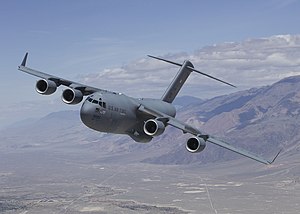Boeing C-17 Globemaster III
| C-17 Globemaster III | |
|---|---|
 |
|
| The prototype C-17, known as T-1, flying a test sortie in 2007 | |
| Role | Strategic and tactical airlifter |
| National origin | United States |
| Manufacturer | McDonnell Douglas / Boeing |
| First flight | 15 September 1991 |
| Introduction | 17 January 1995 |
| Status | In service |
| Primary users |
United States Air Force Indian Air Force Royal Air Force Royal Australian Air Force |
| Produced | 1991–2015 |
| Number built | 279 |
| Unit cost |
US$218 million (flyaway cost for FY 2007)
|
| Developed from | McDonnell Douglas YC-15 |
The Boeing C-17 Globemaster III is a large military transport aircraft. It was developed for the United States Air Force (USAF) from the 1980s to the early 1990s by McDonnell Douglas. The C-17 carries forward the name of two previous piston-engined military cargo aircraft, the Douglas C-74 Globemaster and the Douglas C-124 Globemaster II. The C-17 commonly performs tactical and strategic airlift missions, transporting troops and cargo throughout the world; additional roles include medical evacuation and airdrop duties. It was designed to replace the Lockheed C-141 Starlifter, and also fulfill some of the duties of the Lockheed C-5 Galaxy, freeing the C-5 fleet for outsize cargo.
Boeing, which merged with McDonnell Douglas in the 1990s, continued to manufacture C-17s for export customers following the end of deliveries to the U.S. Air Force. Aside from the United States, the C-17 is in service with the United Kingdom, Australia, Canada, Qatar, United Arab Emirates, NATO Heavy Airlift Wing, India, and Kuwait. The final C-17 was completed at the Long Beach, California plant and flown on 29 November 2015.
...
Wikipedia
